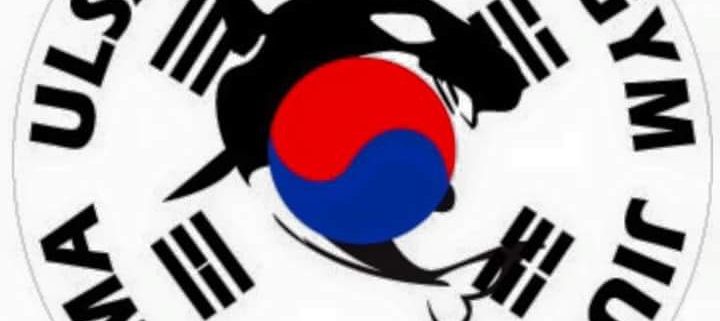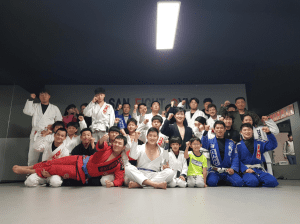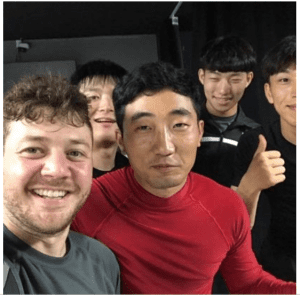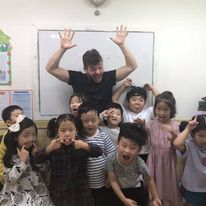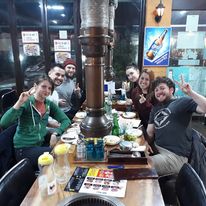Starting Jiu Jitsu as an Expat in South Korea
Dust Mop Jiu Jitsu: The Expat Files: Chapter One: Ulsan Fight Gym-Ulsan, South Korea
-On getting better each day, hacks for remembering Korean names and staying calm while being choked.
What is this project?
At current count, I have done at least one lesson at thirty separate Jiu Jitsu studios. In 2018, I started BJJ in South Korea and moved to Burlington, Vermont. The pandemic brought me to the Berkshires (western Massachusetts) and then, in september 2021, to Amherst (same state but more East). Throughout my journey, I’ve tried to keep up with going to class at least three times a week. If I found myself out of those four locations, I went to lessons wherever I could find them. Visiting family in Nebraska, attending academic residencies and visiting potential universities with my wife gave me the opportunity to see Jiu Jitsu in multiple states, countries and continents.
Partially because of all the moving, I’m still a white belt. I’ve been trying to make sense of all the time I’ve dedicated to my sport. I’ve gained so much with regard to physical health, confidence and social connections. Yet I keep focusing on the Blue Belt that has continued to elude me. People love to say that Jiu Jitsu is great for keeping your ego low, but I have to admit that I get uncomfortable when people ask me what belt I am. After four years, it can sometimes feel embarrassing to say white.
If you stick around at one gym, my assumption is that eventually you will get a Blue Belt. The gyms I’ve been to don’t want to give one to a guy who’s only been around a few months. They want to be able to take stock in your progress and see your journey. That leads me to this project. I need to take it upon myself to reflect on that journey rather than waiting for someone else to do it for me. Without the promise of a belt, I’ve had to find more subtle ways to mark moments of growth.
The name “Dust Mop Jiu Jitsu” represents my belief that I’ve taken crumbs from everywhere I’ve been. I’ve told myself that seeing all of these gyms has been good for my Jiu Jitsu. But I haven’t really taken the time to reflect on how attending classes while globetrotting has actually helped me. I can’t claim to remember everything I learned from each place. That’s why I feel like a dust mop as opposed to a sponge. But my thought is that, through writing, I will be able to remember at least one way that each gym has contributed to my BJJ repertoire in the form of a technique, a life lesson or an interesting story.
This blog is dedicated to the coaches and students who I’ve learned with along the way. You’ve influenced me more than you can know.
–
This is the first chapter of what I’m calling the Expat Files. It starts when I was living abroad until I found a permanent gym in the states.
–
I began my Jiu Jitsu journey in Ulsan, South Korea. Growing up I had always loved Martial Arts. As a kid, I did Karate and watched every Jackie Chan movie. I quit by sixth grade and rediscovered my interest in my teens. My older brother got really into watching Bruce Lee movies and we would break things around the house trying to recreate our favorite scenes from Drunken Master.
Arthur, a highschool buddy of mine, got jazzed into it too after I introduced him to Human Weapon. We roped in our friend Rae’e and would practice sparring in my parents house or outside the cafeteria at school. Looking back, we must have looked like absolute jackasses trying to pull off flowery kicks on each other.
Arthur heard that Brazilian Jiu Jitsu was this mysterious art where a little guy could beat a bigger person. He ended up trying Jiu Jitsu in college for a year but I was too intimidated. Ten years passed by and I pulled every excuse in the book not to try it out. I told myself that I was too tired after work, too out of shape to start and not aggressive enough to make it my hobby. It didn’t help that Arthur, forever a gym rat and always in way better shape, had made his practices in college sound like the most intense workouts he’s ever done. There was even a gym around the corner from my house near Boston and instead of going to it I waited until I was halfway around the world to give grappling a shot.
I know I’m not alone in starting later than I wanted. Almost every BJJ practitioner I know delayed starting because they weren’t strong/fast/good enough to start. Those same people always wish they had gotten over that and started earlier.
I moved to South Korea in the fall of 2017 to be an English teacher. After being there a few months, my girlfriend (now my wife) Rachel, asked if I wanted to try Taekwondo. “It’s the national sport after all” she said, “we might as well try it.” I hadn’t done a martial art since Karate in elementary school. But doing kicks with a few Korean teenagers and some extremely awkward expats made me realize that it was BJJ that was calling my name.
I was thinking of sticking with Taekwondo and maybe trying BJJ once I felt strong enough. That’s a moving goal post. I still hear this all the time from friends that are flirting with joining. “I’m getting stronger, I think I’ll do it once I feel ready.”. Every BJJ practitioner I know thought they weren’t strong/fast/good enough to start. They all wish they had started earlier and gotten over those fears sooner. One Chewjitsu video in particular helped me realize that I would never be ready, but I would kick myself for hesitating once I started. On facebook, I found the closest academy which turned out to be Ulsan Fight Gym.
The first lesson, Jang Jiwoon, the instructor took me aside and gave me a brief intro. Jiwoon’s English was good but the class was entirely taught in Korean (which I don’t speak). We then started the class with shrimping (which I couldn’t figure out), reverse shrimping (which I couldn’t figure out) and the move of the day. My first ever technical lesson in Jiu Jitsu was the Kimura from a closed guard (which I couldn’t figure out). At the end of fifty minutes, they always did five minute rounds for half an hour. I didn’t expect my instructor to allow me to spar on the first day. I shakily walked over to a nice dude with glasses and a bowl cut who smiled and gestured for me to sit down. I panicked and bucked around. I somehow got the Kimura and my first ever tap. From that moment, I was hooked. That night, I lay awake in bed and I couldn’t sleep. It felt the same as when you start dating someone and you think it might be true love.
I started with two days of training a week and did my damndest to make it three. I already fantasized about doing it all day every day. Only problem was, I couldn’t always understand the lessons. Almost all of them were in Korean. The instructor spoke English but I couldn’t make him give me private directions each time.
The people in the gym were always nice to me. But it was mostly an athletic experience and not a social one. Most South Koreans learn English in school. At the same time, most in my city didn’t really feel comfortable speaking it. There’s an interesting dynamic at play. If you look at test scores, South Koreans have really high grades in English but don’t really need it to have a stable career. It’s like learning advanced math in school and realizing that you’ll never use it beyond your college exams. Asking someone there to speak English is like asking an American to do calculus on the spot. The exception was Ho Chun (red rash guard above), who quickly became my favorite training partner since he loved to make crazy inappropriate jokes in English all the time. With that language barrier, most of my friends that year were American, French, Italian, British and South African. I think Ho Chun was the closest thing I made to a Korean friend.
Of course there were other characters that I grew to love at the gym. The two teenagers on the right of the picture would always chase each other around like dragon flies trying to mate. The kids were really fun and would always pull out their best English with me. One heavyset blue belt would practice shadow boxing with one of those low-oxygen masks and collapse in a puddle in the corner before practice. This old truck driver would try to snap my achilles in half and laugh hysterically whenever I tapped to the pain. Actually, come to think of it, I didn’t like that last guy too much.
Part of the obstacle to getting close to people is also the Korean names. Every Korean name, without exaggeration, has three syllables. The first one is the family name, and then the personal name i.e. Kim (family) Jong Un (given name). That makes it really hard to distinguish people’s names from each other. Remembering names is a prerequisite for friendship in my book
Another peculiar thing is that it’s common for Koreans to pick English names in elementary school and stick with them throughout their education and sometimes their career. I did that in the states in Spanish class but only for the first year (for the record, in sixth grade, I went by Alfredo). There, they did that much earlier, used them for longer, and it seemed like a bigger part of their academic identity. Sandra, a Korean teacher at the school, and I had a conversation about that naming process. I noticed all of the kids call her Sandra, even when they are speaking Korean.
Me: How did you come by the name Sandra? Did you choose it?
Sandra: Actually I changed it in middle school. I started with the name Monica at age five. My parents picked that name. But as more kids started to learn more English, they made fun of me by calling me Harmonica. So I made the decision to change it to Sandra.
I saw a huge variety in these chosen English names. It was only two years post Frozen so there were a lot of Elsa and Anna’s. There were plenty of biblical names like Daniel and Isaac. Some parents opted for using the Korean names (like one of my favorite kids, Ju-Ha). But sometimes parents let the kids pick their own names and the results could be pretty entertaining. The following are a list of names that I, or my coworkers, actually taught:
- Pikachu
- Black Joe (Named after a candy bar)
- ABC
- Dragon
- Luigi
- King’s Guys
It bothered me, however, that I could not remember Korean names. I pride myself on being able to remember names no matter the culture, so I found a good work around. My BJJ coach explained that all I had to do was remember if people were older than me or younger. Apparently it’s totally acceptable to just call somebody by their age honorific. It’s a pretty simple system.
| Are they… | Call them: | Translation |
| Younger? | Dong-Sang | Younger Sibling |
| Much younger (boy)? | Alla | Not sure, never looked it up |
| Same age? | Chingu | Friend |
| Older (man)? | Hyun | Older Brother |
| Older (woman)? | Noona | Aunt |
| Much older (man)? | Appa | Uncle |
| Much older (woman)? | Ajima | Old lady/bag/bat. Actually, don’t call them that…But that’s kind of what it means |
Still, even if I was getting a handle on addressing people. I was clearly missing key concepts since all the instructions were in Hangul. To learn more, I started finding as much content online to help explain the fundamental concepts. Joe Rogan, Sam Harris, Jocko Willink, Nick “Chewy” Albin, Stephan Kesting, Rokas “Martial Arts Journey” Leo and Budo Jake became my English speaking mentors. I started to understand more and got fascinated by the principles that were so critical in the sport. I watched a Rolled-Up episode with Jeff Glover that helped me do a mounted triangle for the first time. “Remember guys, it’s not called a tri-in-front-of-the-guy-choke, it’s a tri-angle choke, you gotta pivot.” Those little details helped me learn how to survive.
Like most over-excited newcomers I got a few injuries. I bruised a rib and did something weird to my elbow. It forced me to pull out of what would have been my first competition. I still went, watched, and wondered if I would ever get the opportunity to compete. The thought both exhilarated and terrified me. I’m not a very competitive or aggressive person, but I wanted to prove to myself that I could do it. It would be another year until that happened.
In hindsight, it’s a good thing I pulled out of that competition. I had started intermittent fasting and was losing weight rapidly. Being an American, I never really got a handle on Kilos as a measurement so I was not sure if I had given an accurate number for a weight class. But I know I lost 15 pounds easily. It was not just the IF that did it. I’ve never considered myself fat but I never had that much control when it comes to food either. Early on I learned that BJJ makes you crazy nauseous if you eat right before coming to class. I remember wanting to puke my second lesson. I ate an hour before the class because I didn’t want to train hungry. But I learned to make a buffer of two hours between meals and rolling. Additionally, I started to avoid sugar on days I attended class. Because of this, I remember turning down a free donut before heading to UFG and thinking that I had never in my life refused a pastry. The pictures below will show what I looked life before and after I started doing BJJ.
In July, our contract with the school was almost up. Rachel asked me what I wanted to do when we eventually returned to the states. Before getting to Korea I was actually pretty lost in my life. I worked in outdoor education for a while and got tired of that. I had earnestly looked into becoming a Rabbi but ended up deciding that it wouldn’t be a good fit for me. A few weeks after starting BJJ, I started a masters in Mental Health Counseling but didn’t have a plan for anything related to work. I also didn’t know if I wanted to be a therapist or just enjoyed learning about the concepts. All I knew for sure was that I wanted to continue doing Jiu Jitsu. After all, this felt like the best therapy I had ever received.
It’s the tap that really makes Jiu Jitsu special. In outdoor education we talk a lot about trust building. Mostly we do that through climbing and belaying and learning to trust. But I felt that getting submitted is what really builds the most amount of trust in any sport I’ve ever done. When you tap to a choke, you are communicating clearly that if you keep going, I will die. The fact that you let go instantly builds a feeling of safety that I had never experienced prior.
My first week, I remember how quickly I would tap as soon as somebody put their arm around my neck. But after a few weeks, I would start to notice I was still breathing. Just because the arm is there, doesn’t mean they have me. I don’t need to panic. I have options. That realization has carried me in stressful moments outside the sport.
At Ulsan Fight Gym, they did skill demonstrations for their stripes. I prepared with a wiry Korean dude who went by the English name Adam. I worked hard and got my stripe but honestly what I’ll always remember from that night was waiting for everyone to be done. This older dude, Jae-Min, tapped me on the shoulder and said, “This very boring!” We both burst out laughing.
After four months of training at UFG, I was about to hit the road. Schools in South Korea usually give you a finishing bonus when your contract is over. Most people take that money and travel a little bit before returning home. That was our plan. We wanted to see a little more of Asia, meet up with Rachel’s parents in Denmark, go to Spain for the Camino De Santiago and then get home in time for Rae’e’s wedding in Boston. But I wondered how I would continue my training. That’s how I discovered BJJ globetrotters. One google search of, “how do you train BJJ while traveling.” Finding the site, I was so relieved to know that I could keep my progress while training! I used their website and facebook pages to look at possibilities for learning BJJ post Korea. If you’re curious about what that was like, be sure to look out for my next article where I talk about my time in Bangkok, Thailand.
The last night I was in Korea, I went to UFG. They surprised me with a cake and said goodbye to me. Jiwoon told me how lucky I was that I would be able to meet Black Belts in the states. Ho Chun, the wonderful weirdo, bought me a bag of socks. Four years later, I think I still have two pairs.
I still keep in touch a little bit with the gym. Whenever I compete in a tournament, I send them some pictures. Someday I hope to go back and visit. The language barrier will still be there, but at this point, I’m positive our Jiu Jitsu can do most of the talking.
The Dust Mop takeaway:
So what did I learn from UFG? Technically I gained a lot of movement and skill. It’s almost a cliche to say that your first few months are usually spent getting murdered by everyone in BJJ. Those first few months were all in Korea so I never really got to see the other side of the hump except for a few clunky submissions scored on people newer than me.
I learned here the lesson that most new, not-particularly-athletic white belts need to learn. Forget about winning and losing. Take stock of what happened in the roll and let yourself know at least one thing that went well. I would do this by telling myself:
“I know I did something right because I got back to my guard”
“I know I did something right because he had his arms around my neck and I didn’t give up.”
“I know I did something right because he worked harder than he normally does.”
You gotta take the perspective that you are getting a little better each day.
–
My goal is to visit 100 gyms! If you ever want me to visit yours and write about what it’s like to learn from you, feel free to reach out at Du*************@***il.com.

